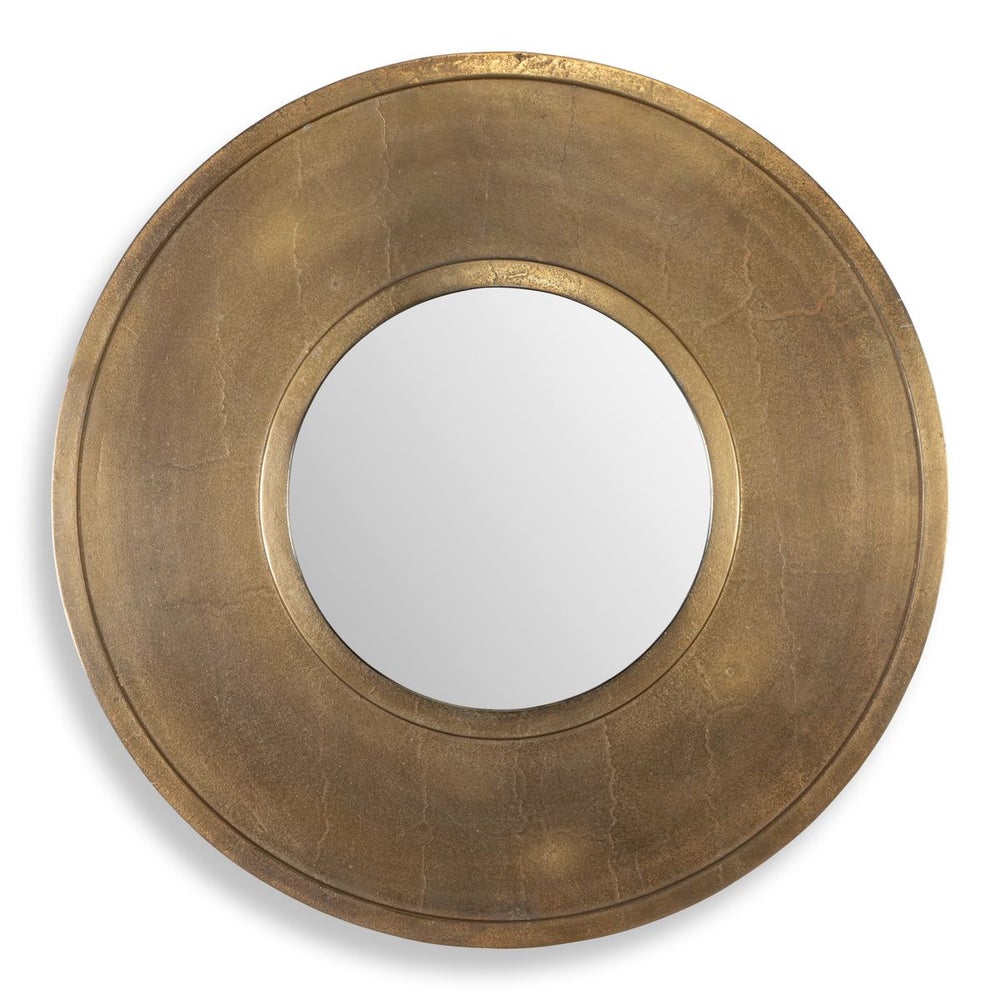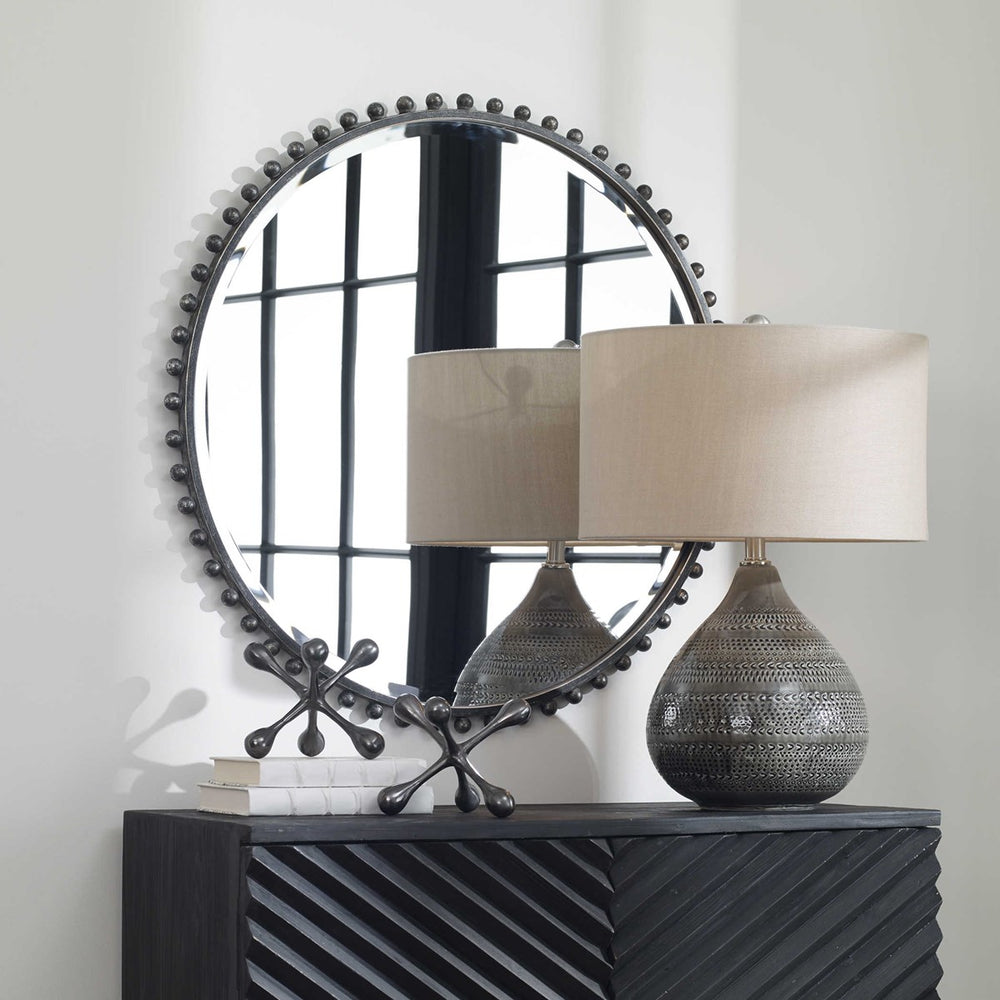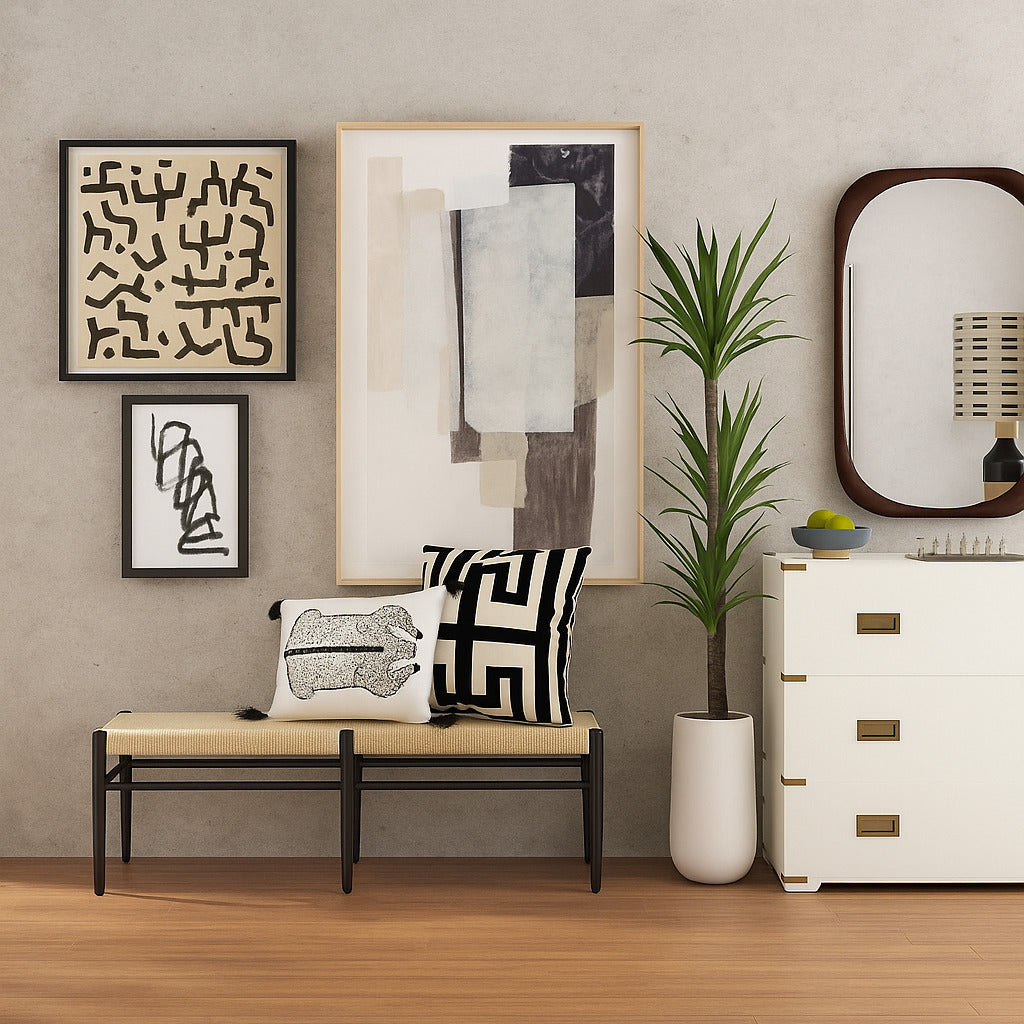Set mirrors for users first, room second. Aim for clear face view, comfortable posture, even light.
Fast rules
- Center height lands 57 to 65 inches above finished floor (start at 60).
- Bottom gap sits 5 to 10 inches above the countertop or sink rim.
- Width reads best when the mirror is a bit narrower than the vanity (leave 1 to 2 inches each side).
- For vessel sinks, measure the gap from the sink rim, not the counter.
- For tall users, raise the center so eyes and hair are visible without tilting.

Additional information for designers
- Thin frames keep visual width generous, a clean black like Black Vanity Mirror suits modern baths.
- Thicker frames reduce apparent size, consider a brighter metal like Antique gold lead mirror angled on white background. if you want edge definition.
- Use 5 to 6 mm glass and sealed edges in humid rooms to reduce distortion and rot.
- Mock the center with painter tape before drilling, confirm sight lines for all users.
How to place it
- Measure constraints (vanity height, faucet, backsplash, ceiling, lights, user eye heights).
- Mark a 60 inch center, adjust for the shortest and tallest primary users.
- Set the bottom edge 5 to 10 inches above the counter or sink rim.
- Confirm top clearance to ceiling and lights (leave a few inches of breathing room).
- Size the width to the vanity bay, then center the mirror.
Additional information for designers
- Arched profiles help when the wall is tall, a warm option is Antique Brass Arched Mirror.
- Tile walls need rated anchors and a masonry or diamond bit, confirm no plumbing in the drill path.
- Hardware choice affects clearances, french cleat or z clips change the top reveal.
- Asymmetrical sinks center to the bowl, not the vanity.
Size matrix (quick picks)
| Vanity width | Mirror width | Notes |
|---|---|---|
| 24 in | 20 to 22 in | Single sink |
| 30 in | 26 to 28 in | Single sink |
| 36 in | 32 to 34 in | Single sink |
| 48 in | 44 to 46 in | Single or two small mirrors |
| 60 in double | Two mirrors 20 to 24 in each | Center each to its sink |
| 72 in double | Two mirrors 24 to 28 in each | Or one large mirror spanning both |
For 30 to 36 inch vanities, a curved rectangle like Black Vanity Mirror 24x36 fits well, for wide singles try a simple metal frame such as Gold Rectangular Mirror Plain.
Additional information for designers
- Mirror height drives posture, 30 to 40 inches tall works in most rooms, go taller with nine foot ceilings.
- Bevels read traditional, square edges read modern, low iron glass preserves true whites.
- Custom lead times vary, hold two to four weeks in the schedule.
Lighting coordination
- Over mirror bars center at 75 to 80 inches, or about 3 inches above the mirror top.
- Side sconces center at 60 to 66 inches, spaced 28 to 36 inches apart, set a few inches off the mirror edge.
- Lenses at or near eye height give even face light.
Integrated options simplify placement, round and warm reads well like Lighted round gold mirror over a marble vanity. or a sharp dark profile like Lighted Black Vanity Mirror. A perimeter glow in brass complements warm metals, see Gold Vanity Mirror with Lights Behind Hanging Above a Pink Vanity and gold faucet.
Additional information for designers
- Target 90+ CRI at 2700 to 3000 K for skin tone accuracy.
- Avoid downlight only, add vertical light from both sides where possible.
- Check backplate sizes against mirror edges so trims do not overlap, confirm damp or wet listings.
- Integrated LED mirrors need a switched junction box behind the glass.
Accessibility and kids
- Family baths do best with a taller mirror or a full height panel for mixed ages.
- Drop the center toward a child user, or add a second full height mirror near the vanity.
Warm metals stay friendly in family spaces, a classic choice is Arched Mirror Gold, cooler rooms can use Silver Vanity Mirrors to match chrome or nickel faucets.
Additional information for designers
- Plan seated sight lines at makeup areas, consider a tilt mirror if the counter includes a knee space.
- Rounded corners reduce risk in kids’ baths.
- Use cleats into studs where possible, verify anchor ratings against actual weight.
ADA compliance details
- Bottom of the reflecting surface sits 40 inches maximum above finished floor.
- Top edge of the reflecting surface hits 74 inches minimum above finished floor.
- Full height mirrors make compliance simpler for mixed height users.
- Local building codes may add rules, check with the local authority or ICC A117.1 where adopted.
A simple rectangular profile is easy to place within these limits, examples include Bronze Bathroom Mirror and Nickel beaded vanity mirror (warm or cool metals, same layout logic).
Additional information for designers
- Provide at least one compliant mirror per accessible bathroom.
- Medicine cabinets must also meet the 40 inch and 74 inch rules for the reflecting surface.
- Keep clear floor space in front of the mirror per the access plan.
Proportionality and design logic
- Rule of thirds helps, divide wall height from vanity top to ceiling into three bands, place mirror boundaries near those lines.
- Height ratio at 50 to 70 percent of clear wall height reads balanced.
- Width at 85 to 95 percent of the vanity bay leaves a clean reveal.
- Sight lines improve when tops align with tile courses or window heads.
Curves soften strict grids, a scalloped edge like Black Scalloped Vanity Mirror. breaks up hard tile lines, arched brass such as Brass Arched Gold Mirror warms cool stone.
Additional information for designers
- With nine foot ceilings increase mirror height rather than raising the center.
- Heavy frames read smaller than glass edge mirrors, adjust width upward when frames are thick.
- Paper or cardboard templates are cheap and accurate for proportion tests.
Vessel sinks
- Measure the bottom gap from the vessel rim, not the counter.
- Hold 5 to 10 inches from vessel rim to mirror bottom for splash control.
- Confirm faucet arc and spout clearance, keep the mirror bottom 1 to 2 inches above the highest splash point.
- Choose taller mirrors since the vessel raises the baseline.
Arched and oval shapes track well with vessels, try Oval Beaded Mirror Frame for classic rooms, or a warm metal like Champagne Bronze Mirror. for soft contrast.
Additional information for designers
- Set outlet heights after the vessel choice, not before.
- Plan faucet reach so water lands near the drain center, this reduces splash on the mirror edge.
- Seal at the wall to protect the mirror backing from steam and spray.
Wall mounted faucets
- Lay out faucet and trim centers first, then place the mirror.
- Hold the mirror bottom 2 to 3 inches above the spout outlet and clear of handle trims.
- Leave service clearance for trim removal and valve access.
- If the spout sits high, only lower the mirror center if both primary users still see eyes and hair clearly.
Crisp rectangles keep lines clean around wall trims, consider Horizontal silver bathroom vanity mirror. for cool schemes or Two Tone Mirror when mixing metals.
Additional information for designers
- Common spout centers land 42 to 45 inches above the floor, verify with submittals.
- Narrower mirrors help when trims sit near the sink centerline.
- Anti fog pads are useful where warm water runs often.
Uneven walls and precision install
- Check the wall with a long straightedge or a six foot level, note bows and crowns.
- Project laser lines for level and plumb, mark where the frame deviates.
- Use thin composite shims behind the frame at low spots until the frame meets the laser lines.
- Mount with a french cleat into studs, micro shim lower corners to eliminate wobble.
- If bow exceeds one quarter inch across mirror width, use a standoff frame or a full backer panel.
Wavy walls hide better with forgiving profiles, a textured white like White wavy mirror. can mask slight irregularities at the edges.
Additional information for designers
- Use two playing cards as feeler gauges to find gaps.
- Add clear bumpers at lower corners to protect tile and keep the plane true.
- On tile, pre tape with painter tape to prevent bit wander and chipping.
FAQs
There is no single standard height, use eye level as the anchor and adjust for the users.
Medicine cabinets follow the same center and gap, confirm door swing and sconce clearance.
Tall ceilings call for taller mirrors, not a higher center.
Warm-toned metals add softness, see White and Gold Mirror., cool metals pair with chrome, see Antique Silver Mirror.
Additional information for designers
- Defoggers and backlit mirrors need a power and control plan (switch or timer).
- Adhesive set mirrors are minimal but harder to service, mechanical mounts remove cleanly.
- Verify weight against anchors and wall type.
- Seal edges where water splashes to prevent rot.
Cheat sheet
- Center 57 to 65 inches (start 60).
- Bottom gap 5 to 10 inches.
- Width equals vanity minus 2 to 4 inches.
- Raise for tall users, lower for kids.
- Coordinate lights early.
Need a quick pick that plays with most finishes, try Black Arched Mirror in Bedroom. for contrast or Arched Mirror Gold for warmth.
Additional information for designers
- Field checklist, studs marked, power located, plumbing mapped, tile layout set, mirror size confirmed.
- Dry fit with tape, get client sign off, then drill.
- Keep a spare hardware kit and extra rated anchors on site.







